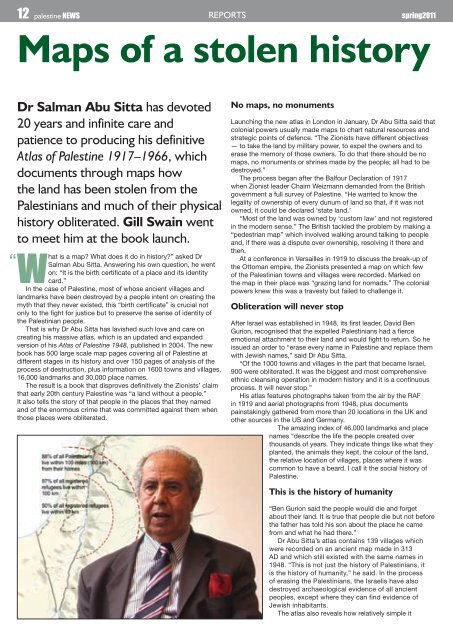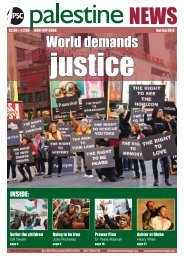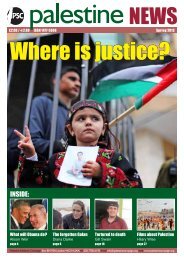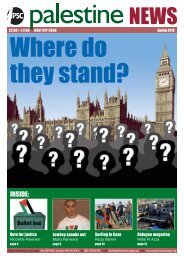InsIDe: - Palestine Solidarity Campaign
InsIDe: - Palestine Solidarity Campaign
InsIDe: - Palestine Solidarity Campaign
Create successful ePaper yourself
Turn your PDF publications into a flip-book with our unique Google optimized e-Paper software.
12 palestine news reportsspring2011Maps of a stolen historyDr Salman Abu Sitta has devoted20 years and infinite care andpatience to producing his definitiveAtlas of <strong>Palestine</strong> 1917–1966, whichdocuments through maps howthe land has been stolen from thePalestinians and much of their physicalhistory obliterated. Gill Swain wentto meet him at the book launch.What is a map? What does it do in history?” asked DrSalman Abu Sitta. Answering his own question, he wenton: “It is the birth certificate of a place and its identitycard.”In the case of <strong>Palestine</strong>, most of whose ancient villages andlandmarks have been destroyed by a people intent on creating themyth that they never existed, this “birth certificate” is crucial notonly to the fight for justice but to preserve the sense of identity ofthe Palestinian people.That is why Dr Abu Sitta has lavished such love and care oncreating his massive atlas, which is an updated and expandedversion of his Atlas of <strong>Palestine</strong> 1948, published in 2004. The newbook has 500 large scale map pages covering all of <strong>Palestine</strong> atdifferent stages in its history and over 150 pages of analysis of theprocess of destruction, plus information on 1600 towns and villages,16,000 landmarks and 30,000 place names.The result is a book that disproves definitively the Zionists’ claimthat early 20th century <strong>Palestine</strong> was “a land without a people.”It also tells the story of that people in the places that they namedand of the enormous crime that was committed against them whenthose places were obliterated.No maps, no monumentsLaunching the new atlas in London in January, Dr Abu Sitta said thatcolonial powers usually made maps to chart natural resources andstrategic points of defence. “The Zionists have different objectives— to take the land by military power, to expel the owners and toerase the memory of those owners. To do that there should be nomaps, no monuments or shrines made by the people; all had to bedestroyed.”The process began after the Balfour Declaration of 1917when Zionist leader Chaim Weizmann demanded from the Britishgovernment a full survey of <strong>Palestine</strong>. “He wanted to know thelegality of ownership of every dunum of land so that, if it was notowned, it could be declared ‘state land.’“Most of the land was owned by ‘custom law’ and not registeredin the modern sense.” The British tackled the problem by making a“pedestrian map” which involved walking around talking to peopleand, if there was a dispute over ownership, resolving it there andthen.At a conference in Versailles in 1919 to discuss the break-up ofthe Ottoman empire, the Zionists presented a map on which fewof the Palestinian towns and villages were recorded. Marked onthe map in their place was “grazing land for nomads.” The colonialpowers knew this was a travesty but failed to challenge it.Obliteration will never stopAfter Israel was established in 1948, its first leader, David BenGurion, recognised that the expelled Palestinians had a fierceemotional attachment to their land and would fight to return. So heissued an order to “erase every name in <strong>Palestine</strong> and replace themwith Jewish names,” said Dr Abu Sitta.“Of the 1000 towns and villages in the part that became Israel,900 were obliterated. It was the biggest and most comprehensiveethnic cleansing operation in modern history and it is a continuousprocess. It will never stop.”His atlas features photographs taken from the air by the RAFin 1919 and aerial photographs from 1948, plus documentspainstakingly gathered from more than 20 locations in the UK andother sources in the US and Germany.The amazing index of 46,000 landmarks and placenames “describe the life the people created overthousands of years. They indicate things like what theyplanted, the animals they kept, the colour of the land,the relative location of villages, places where it wascommon to have a beard. I call it the social history of<strong>Palestine</strong>.This is the history of humanity“Ben Gurion said the people would die and forgetabout their land. It is true that people die but not beforethe father has told his son about the place he camefrom and what he had there.”Dr Abu Sitta’s atlas contains 139 villages whichwere recorded on an ancient map made in 313AD and which still existed with the same names in1948. “This is not just the history of Palestinians, itis the history of humanity,” he said. In the processof erasing the Palestinians, the Israelis have alsodestroyed archaeological evidence of all ancientpeoples, except where they can find evidence ofJewish inhabitants.The atlas also reveals how relatively simple it







